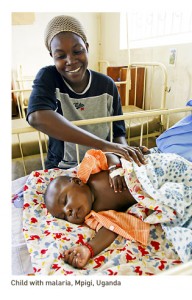According to statistics from ministry of health, in Uganda, malaria has historically been a very serious health problem and currently poses the most significant threat to the health of the population. It accounts for 25-40% of all outpatients’ visits at health facilities, 20% of hospital admissions and 15% of in-patients deaths and has a case-fatality rate of 3-5%.
Malaria is a leading cause of morbidity and mortality especially in children below 5 years of age in Uganda where it can account for up to 70% of Out-patient attendances and over 50% of In-patient admissions.
Based on findings from a verbal autopsy study in western Uganda 2005, it is estimated that 23% and 11% of deaths among children under 5 years are attributable to malaria.
Malaria and other health conditions do not only cause ill health and death but also has a great impact on the social and economic development of the individual, the family, the community and the nation at large.
Families, which are poor, find it extremely difficult to access treatment due to lack of money to buy drugs but also due to long distances to health centers.
A poor malaria-stricken family may spend up to 25% of its income on malaria treatment and prevention. Household surveys in Kabarole and Bundibugyo Districts showed that the direct cost of treatment for an episode of suspected malaria averages 4,500 Ug.Shs in urban settings and 2,000 Ug.Shs. in rural populations.
Treating children suffering from malaria
This unit in a document on management of malaria in children under-five years recommends an oral dose of chloroquine and one dose of paracetamol for the high fever.
Parents are also advised to return children to medical personnel immediately for follow up, especially if the fever persists for more than seven days.
Prevention is however better than cure. It is a better option therefore for parents to protect their children from malaria. This is greatly by preventing their children from being bitten by mosquitoes.
Insecticide treated mosquito nets are recommended for all children under five years.
Putting mosquito screens, spraying walls with recommended chemicals and early closure of windows and doors reduces the risk of being infected by the malaria parasite.
Parents are in addition advised to prevent mosquitoes from breeding by clearing bushes and draining stagnant water around homesteads.
The under five mortality of 159/1000 live births (Demographic and Health Survey 1995) in Uganda translates into a malaria specific mortality of 37/1000 in high malaria endemic areas and 18/1000 in low endemic areas or a total of 70,000-110,000 child death annually. In a September 2005 health guide for health workers by ministry of health, the director general of health services, Doctor Sam Zaramba, rated malaria the most frequent cause of attendance at health facilities.
“Malaria kills more people than any other single disease in Uganda,” he wrote. This has been the story about this disease however for the last thirty years although malaria is preventable and curable. To date malaria posses the biggest threat to the health of the young and old.
“Malaria is referred to as the number one cause of miscarriage in Uganda. About 80,000 children under five years are reported to being killed by malaria every year in Uganda,” confirms the Malaria Consortium and Global Fund to Fight AIDS, TB and Malaria, confirms in a document on malaria in children under five years and pregnant women.
Malaria is an acute febrile illness caused by a malaria parasite called a plasmodium. The female anopheles mosquito transmits this plasmodium. In children under five years malaria presents itself in fever, high temperatures, loss of appetite, weakness, lethargy and vomiting. Other than death, malaria has other health effects on children.
“Available records indicate malaria as the underlying factor for mental retardation to one in every two children below five years admitted due to malaria.” (Ministry Of Health April 2002). Malaria is further sighted as leading cause of childhood anaemia, stunted growth, mental retardation and absenteeism from school and thus affecting school performance. It is estimated that in endemic areas like Uganda, malaria may impair as much as 60% of the schoolchildren’s learning ability. It is also estimated that, children under 5 years old in endemic areas like Uganda suffer an average of 6 episodes of malaria each year. With acute disease a child may die within 24 hours. Dr S. Zaramba explains that malaria also results into scholastic failure due to high absenteeism, poor concentration and performance of both the child and teacher. “…children who are sick are not able to go school…” he says.
Disease contributes a great deal to poverty in a nation and so has this malaria disease. Muhwezi states that malaria impacts negatively on the household, community incomes and the national income. Malaria among children also has great impact on the economic development of individuals. The Malaria Control Unit in April 2002 reported nearly 10% of household incomes being spent on treatment of malaria. Government too diverts a proportion of the global fund to the fight against malaria. It is to this effect that a Malaria Control Unit was formed by the ministry of health to deal with this epidemic.
By Eunice Rukundo and Isingoma John


One Response to "Uganda fails to curb malaria in Children under five years"